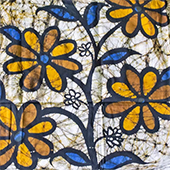Design Resource
Hand Batik Print - Ahmedabad, Gujarat
Art of Decorating The Cloth
by
Prof. Bibhudutta Baral and Ranjitha M. C.
Hand Batik Printing is an art of decorating the cloth. It is believed that the word Batik is derived from the word ‘ambatik’ which means ‘a cloth with little dots’ whereas ‘tik’ means little dot, drop, point or to make dots and it is also believed that a word ‘batik’ originated from the Japanese word ‘tritik’ that defines a resist process for dying. Batik print is a very old form of art, whereas the evidence of early batik print has been discovered in the Middle East, Egypt, Peru, Japan, East Turkistan, Europe as well as Central Asia (India and China) as far back as 2000 years ago. Batik was initially practiced in China as early as the Sui Dynasty (AD581 – 618). The history of Indian batik traced back to 1st century AD. During that period, Khatri community people of Gujarat were the only set of artisans for this Batik art. Now there is no single community who involved in this work, there are artisans of various regions who are trained in hand batik print. In India these Batik printing is done in many places such as Rajasthan, Andra Pradesh, Maharashtra, West Bengal, Madhya Pradesh and Gujarat.
Batik print is a unique technique of colouring or ornamenting the cloth by hiding a part of it with a wax coat and then dyed so that the waxed area keep their actual colour and when the wax is removed, the contrast between the dyed and undyed areas makes the pattern. Batik art involves three stages such as waxing, dyeing and dewaxing (removing the wax). There are some more sub-processes like preparing the cloth, stretching the cloth on the frame, preparing the dye, dye the cloth, dewaxing and washing. Batik production techniques are generally being divided into three types such as Canting (tjanting or tulis), Cap (block printing) and Silk screening (screen printing). Hand Batik printing portrays an array of themes, which include religious themes as well as abstract patterns. The batik print on fabric represents cultural elements of their respective states and also influenced by the nature.





